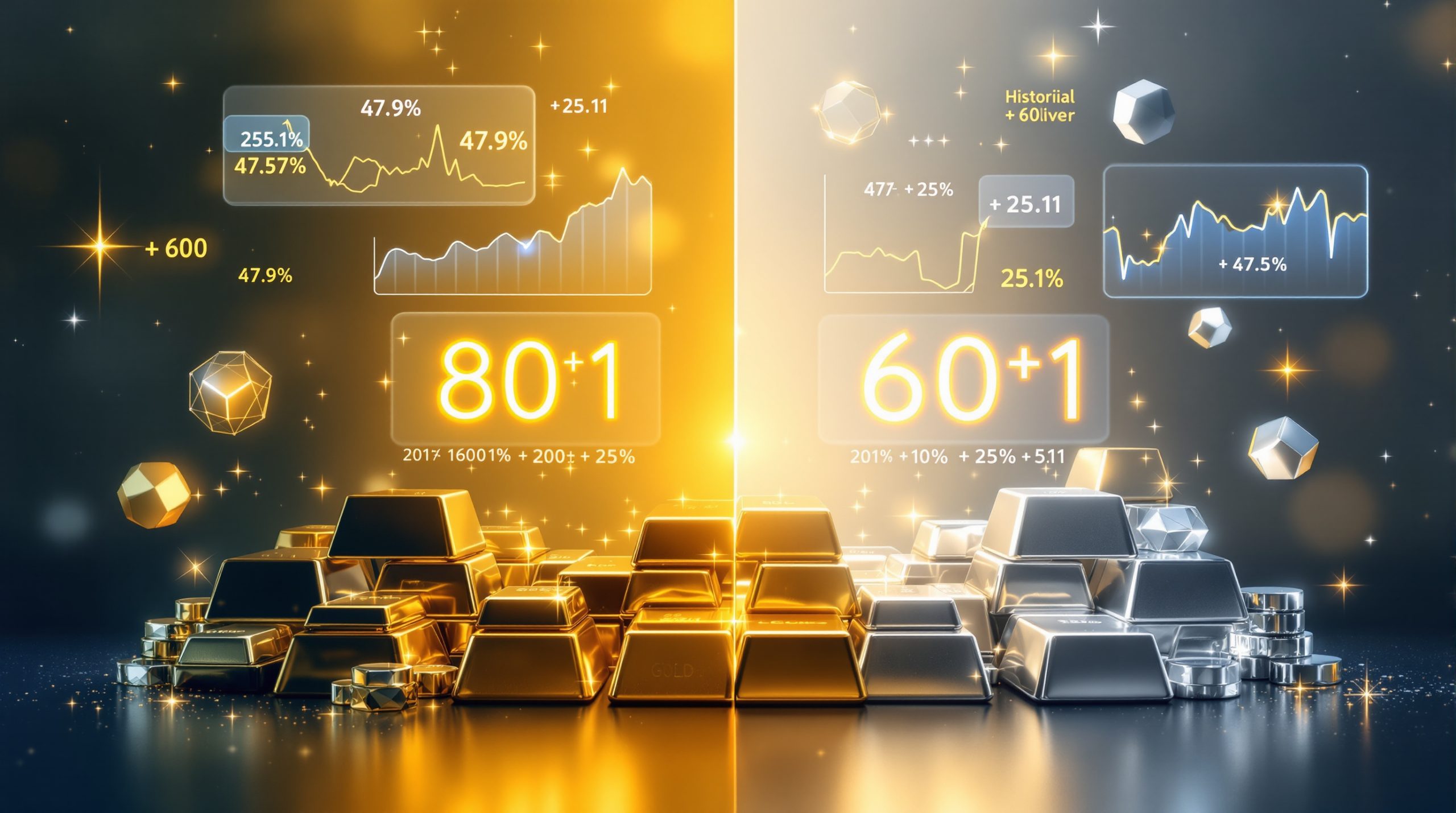How Central Bank Policies Are Revolutionising Precious Metals Markets
Central banking institutions worldwide have fundamentally transformed their approach to precious metals allocation, creating demand dynamics that extend far beyond traditional investment patterns. This institutional shift represents one of the most significant structural changes in precious metals markets since the end of the Bretton Woods system, setting the stage for the next phase of gold and silver market evolution.
Institutional Accumulation Reaches Historic Proportions
The magnitude of central bank gold purchases has reached levels that dwarf historical precedents. According to World Gold Council data, official sector purchases have maintained consistently elevated levels throughout 2024 and into 2025, with quarterly acquisition rates frequently exceeding 200 tonnes. This sustained institutional demand creates a fundamental floor beneath precious metals pricing that differs markedly from previous market cycles.
Eastern European and Asian central banks have led this accumulation trend, with many institutions citing currency diversification and geopolitical risk management as primary motivations. The People's Bank of China, Reserve Bank of India, and Turkish Central Bank have emerged as particularly active participants in this institutional reallocation.
Monetary Policy Shifts Create Favourable Conditions
The Federal Reserve's policy trajectory through 2026 appears increasingly supportive of precious metals appreciation. With inflation concerns persisting despite multiple rate adjustments, monetary authorities face the challenging balance between economic growth support and price stability maintenance.
Current market expectations suggest additional rate modifications that typically correlate with weakened dollar positioning and enhanced precious metals attractiveness. This policy environment creates sustained tailwinds for gold price forecast scenarios, particularly when combined with continued institutional accumulation patterns.
Currency Debasement Concerns Drive Strategic Positioning
Global financial institutions increasingly recognise precious metals as essential hedging instruments against fiat currency uncertainties. The unprecedented monetary expansion witnessed since 2020 has heightened concerns about long-term purchasing power preservation, driving institutional adoption of gold and silver as portfolio stabilisers.
This strategic shift extends beyond traditional safe-haven demand, encompassing systematic portfolio rebalancing toward hard assets that maintain value during periods of monetary expansion and currency volatility. Furthermore, these developments have influenced investment strategy insights that professional fund managers increasingly adopt.
Market Forces Propelling the Current Bull Market Cycle
Contemporary precious metals markets exhibit characteristics that distinguish this cycle from previous bull runs. Multiple converging factors create sustained upward pressure that appears resistant to traditional correction patterns.
Geopolitical Risk Premium Reaches New Dimensions
International tensions spanning multiple regions have elevated precious metals' geopolitical premium beyond historical norms. Trade relationship uncertainties, territorial disputes, and sanctions regimes contribute to sustained safe-haven demand that operates independently of typical economic cycles.
Recent developments in Eastern Europe, Middle Eastern conflicts, and evolving U.S.-China trade dynamics have reinforced precious metals' role as portfolio insurance against geopolitical disruption. This risk premium component adds structural support to price levels regardless of short-term technical factors.
Exchange-Traded Fund Momentum Accelerates Institutional Adoption
Investment vehicles focused on precious metals exposure have experienced substantial capital inflows throughout 2024 and 2025. Major ETFs tracking gold and silver performance have added hundreds of tonnes of physical metal to their holdings, reflecting both institutional and retail investor demand acceleration.
Key ETF Performance Indicators:
- SPDR Gold Shares (GLD) holdings increased by over 150 tonnes during Q3 2025
- iShares Silver Trust (SLV) experienced net inflows exceeding $2 billion in recent months
- Sprott Physical Gold Trust maintained premium pricing indicating strong investor demand
- European and Asian precious metals ETFs recorded similar inflow patterns
Supply Chain Constraints Intensify Physical Market Dynamics
Physical precious metals markets face increasing stress from both investment demand and industrial applications. Silver markets particularly demonstrate vulnerability to supply constraints, with investment-grade material availability showing signs of tightening that could trigger rapid price adjustments.
Refinery capacity limitations, mining production constraints, and elevated fabrication demand create conditions where physical availability may struggle to meet sustained investment flows. This dynamic differentiates current market structure from previous cycles where ample physical supply provided price stability during demand surges.
Gold and Silver Price Trajectories Diverge
The relationship between gold and silver pricing exhibits evolving characteristics that reflect their different supply-demand fundamentals and market applications. Consequently, the next phase of gold and silver markets may see unprecedented divergence patterns.
Gold Market Fundamentals Remain Institution-Driven
Gold's price trajectory continues benefiting from consistent central bank accumulation and monetary policy uncertainties. The metal's primary role as a monetary hedge and store of value positions it favourably within current macroeconomic conditions.
Technical analysis suggests gold has established strong support levels around $2,400-$2,500, with institutional buying providing consistent demand during any price weakness. This institutional support creates a different correction pattern compared to previous bull markets where speculative positioning dominated price action.
Moreover, recent gold highs analysis demonstrates how institutional accumulation patterns have fundamentally altered traditional price discovery mechanisms.
Gold Price Outlook Factors:
- Central bank demand remains structurally supportive
- Monetary policy uncertainty continues through 2026
- Institutional portfolio allocation increases globally
- Technical support levels strengthen with each test
Silver's Industrial Applications Create Additional Upside Potential
Silver presents unique investment characteristics due to its dual monetary and industrial applications. Green energy transitions, technological advancement, and manufacturing demand create additional price support beyond traditional investment flows.
The renewable energy sector alone requires substantial silver quantities for solar photovoltaic installations, with each kilowatt of solar capacity utilising approximately 20 grams of silver. Global renewable energy expansion targets through 2030 suggest sustained industrial demand growth that could exceed readily available supply.
Additionally, the silver market squeeze phenomenon has demonstrated how quickly supply-demand imbalances can manifest in silver markets due to their relatively smaller size compared to gold.
Silver Supply-Demand Dynamics:
| Demand Source | Percentage of Total | Growth Outlook |
|---|---|---|
| Industrial Applications | 65% | Strong growth expected |
| Investment Demand | 20% | Highly variable |
| Jewellery/Silverware | 15% | Stable to modest growth |
Industrial Silver Applications Expanding:
- Solar panel manufacturing: 100+ million ounces annually
- Electronics and electrical components: Critical for conductivity
- Battery technology: Growing importance in energy storage
- Medical applications: Antimicrobial properties drive demand
Investment Strategies for Market Evolution
Navigating the next phase of precious metals markets requires strategies adapted to evolving supply-demand dynamics and institutional participation patterns. However, understanding precious metals technical outlook remains crucial for tactical positioning decisions.
Physical Ownership Versus Financial Instruments
Direct precious metals ownership provides the most complete exposure to supply constraints and monetary hedge benefits. Physical gold and silver eliminate counterparty risk while offering direct participation in scarcity premiums that may develop in tight supply conditions.
However, exchange-traded instruments offer important advantages for tactical positioning and liquidity management. ETFs provide immediate market exposure without storage concerns, while options markets enable hedging strategies for portfolio protection.
Comparison of Investment Approaches:
| Investment Method | Advantages | Considerations |
|---|---|---|
| Physical Bullion | Direct exposure, no counterparty risk | Storage costs, liquidity constraints |
| Precious Metals ETFs | High liquidity, low transaction costs | Management fees, tracking differences |
| Mining Stocks | Leverage to metal prices, dividend potential | Operational risks, management quality |
| Options Strategies | Defined risk, leverage opportunities | Time decay, complexity requirements |
Market Entry Timing and Position Building
Current market conditions suggest that attempting to time significant corrections may prove more challenging than in previous cycles due to strong institutional demand providing price support. Jordan Roy-Byrne, a Chartered Market Technician and publisher of The Daily Gold, warns that investors expecting only brief corrections may face longer periods of volatility than anticipated.
Strategic accumulation during minor pullbacks appears more viable than waiting for substantial price declines that may never materialise. The institutional bid beneath current markets creates different correction patterns compared to historically speculative-driven precious metals cycles.
Furthermore, gold and silver market outlook research suggests sustained institutional buying may limit traditional correction magnitudes throughout the remainder of this bull cycle.
Portfolio Integration Frameworks
Precious metals allocation within diversified portfolios should reflect both defensive positioning against monetary instability and growth potential from supply-demand imbalances. Traditional allocation models suggesting 5-10% precious metals exposure may prove insufficient given current market dynamics.
Strategic Allocation Considerations:
- Conservative portfolios: 10-15% allocation emphasising gold for stability
- Moderate portfolios: 15-20% allocation with gold/silver balance
- Aggressive portfolios: 20%+ allocation including mining equity exposure
- Crisis hedging: Additional tactical allocation during monetary uncertainty
Supply and Demand Factors Shaping Future Performance
Understanding the fundamental drivers of precious metals supply and demand becomes critical for positioning in markets where physical scarcity may increasingly influence price discovery. This analysis becomes particularly relevant when considering the next phase of gold and silver market development.
Mining Production Faces Structural Constraints
Global precious metals mining confronts multiple challenges that limit production growth relative to expanding demand. Regulatory environments have become increasingly complex, with environmental compliance costs rising substantially across major mining jurisdictions.
According to U.S. Geological Survey data, world gold mine production has plateaued around 3,000 tonnes annually, with few major new deposits entering production. Silver production faces additional constraints since approximately 70% comes as a byproduct of base metal mining, creating supply vulnerabilities if copper, zinc, or lead demand weakens.
Key Production Constraints:
- Permitting delays averaging 7-10 years for major projects
- Rising energy and labour costs impacting operating margins
- Declining ore grades requiring more intensive processing
- Limited exploration success in discovering major deposits
- Geopolitical risks affecting production in key regions
Industrial Demand Evolution Accelerates
Technology sector requirements and renewable energy infrastructure development create additional demand pressures beyond traditional investment and monetary uses. The International Energy Agency projects mineral requirements for energy transitions will increase dramatically through 2030.
Silver's unique properties make it irreplaceable in many applications, particularly those requiring high electrical conductivity and thermal properties. Electric vehicle manufacturing, 5G telecommunications infrastructure, and renewable energy systems all require substantial silver quantities that compete with investment demand.
Emerging Industrial Applications:
- Electric vehicle components: Wiring, contacts, and battery systems
- 5G telecommunications: Enhanced conductivity requirements
- Renewable energy storage: Battery technology advancement
- Medical technology: Antimicrobial and biocompatible applications
Investment-Grade Material Availability Tightens
Physical precious metals markets, particularly silver, face potential shortages in investment-suitable forms that could create rapid price adjustments when demand exceeds readily available supply. Refinery capacity has not expanded proportionally to investment demand growth, creating bottlenecks in converting raw materials to investment-grade products.
The London Bullion Market Association reports occasional tightness in good delivery silver bars, while coin and small bar premiums have remained elevated compared to historical norms. These physical market indicators suggest underlying supply stress that may intensify during demand surges.
Preparing for Market Volatility and Uncertainty
The next phase of precious metals markets may present volatility patterns different from historical precedents due to institutional participation and physical supply dynamics. In addition, current market conditions require adapted risk management approaches.
Understanding New Correction Patterns
Traditional precious metals corrections often involved 20-30% price declines lasting several months. However, current institutional demand may create shallower corrections with different characteristics than purely speculative-driven markets experienced historically.
Central bank buying typically accelerates during price weakness, providing support that may limit correction magnitude. ETF flows also demonstrate more stability compared to individual investor behaviour during market stress periods.
Historical Correction Comparison:
| Time Period | Correction Magnitude | Duration | Recovery Pattern |
|---|---|---|---|
| 2011-2015 Bear Market | -45% (Gold), -70% (Silver) | 4 years | Gradual institutional re-entry |
| 2020 COVID Correction | -12% (Gold), -30% (Silver) | 6 weeks | Rapid V-shaped recovery |
| Current Cycle Pattern | Potentially shallower | Variable duration | Institutional support expected |
Risk Management Approaches
Diversification across physical metals, mining equities, and precious metals funds can provide exposure while managing concentration risks and liquidity requirements during various market conditions. Each category responds differently to market stresses and economic conditions.
Risk Mitigation Strategies:
- Geographic diversification: Exposure to different mining jurisdictions
- Storage diversification: Multiple custody arrangements for physical holdings
- Time diversification: Dollar-cost averaging during accumulation phases
- Instrument diversification: Combination of physical, ETFs, and equity exposure
Long-Term Positioning Benefits
The current precious metals cycle appears to have substantial duration remaining based on underlying monetary and geopolitical factors. Patient accumulation strategies may prove more effective than short-term trading approaches given institutional demand patterns and supply constraints.
Important Note: Market participants should prepare for potentially extended periods of volatility rather than expecting brief corrections followed by immediate resumption of upward trends.
Key Risks and Opportunity Costs
While precious metals present compelling opportunities, investors must consider potential challenges and alternative investment performance during evaluation. For instance, understanding market dynamics becomes crucial when positioning for the next phase of gold and silver cycles.
Policy Reversal Scenarios
Significant changes in monetary policy direction or unexpected geopolitical tension resolution could temporarily impact precious metals demand. However, structural trends toward currency diversification and institutional precious metals adoption suggest limited long-term effects from policy reversals.
Federal Reserve policy normalisation could strengthen the dollar temporarily, creating headwinds for gold and silver prices. However, the magnitude of previous monetary expansion suggests policy options remain constrained by debt service requirements and economic growth needs.
Market Timing Challenges and Opportunity Costs
Attempting to optimise entry and exit points in precious metals markets carries substantial opportunity costs, particularly when institutional demand and supply constraints may limit downside while supporting continued appreciation.
Timing Challenge Factors:
- Institutional buying provides unpredictable price support
- Physical supply constraints may trigger rapid price adjustments
- Geopolitical events create unexpected demand surges
- Central bank purchases occur without public disclosure timing
Comparative Investment Analysis
Precious metals positioning should be evaluated against alternative investments' risk-adjusted returns, considering both defensive characteristics and growth potential in current market environments.
Investment Alternative Comparison:
| Asset Class | Risk Level | Inflation Protection | Liquidity | Growth Potential |
|---|---|---|---|---|
| Precious Metals | Moderate | Excellent | Good | Moderate to High |
| Real Estate | Moderate-High | Good | Low | Moderate |
| Equities | High | Variable | Excellent | High |
| Bonds | Low-Moderate | Poor | Good | Low |
| Commodities | High | Excellent | Good | Variable |
Positioning for Precious Metals Market Evolution
The next phase of gold and silver markets represents a convergence of monetary policy shifts, institutional demand patterns, and supply constraints that create fundamentally different conditions compared to previous cycles. These factors suggest sustained strength may continue through 2026 and beyond, though with different volatility characteristics than historically experienced.
Investors seeking to capitalise on these trends should focus on strategic accumulation approaches rather than tactical timing, recognising that institutional participation has altered traditional correction patterns. The combination of central bank demand, ETF flows, and physical supply constraints creates market conditions requiring adapted investment strategies.
Silver presents particularly compelling opportunities due to its dual monetary and industrial characteristics, with renewable energy expansion and technological advancement creating additional demand pressures beyond traditional investment flows. However, this same dual nature may create higher volatility during economic transitions.
Key Strategic Considerations:
- Institutional demand provides structural market support different from previous cycles
- Physical supply constraints may create rapid price adjustments during demand surges
- Industrial applications add fundamental support particularly for silver markets
- Monetary policy uncertainty continues supporting precious metals as portfolio hedges
The precious metals market evolution requires patient capital and strategic thinking rather than short-term speculation. While corrections remain possible and potentially necessary for market health, underlying fundamentals suggest any significant weakness may prove temporary as institutional demand and physical scarcity reassert price support.
Disclaimer: This analysis contains forward-looking statements and market forecasts that involve uncertainties and risks. Precious metals investments carry volatility risks and past performance does not guarantee future results. Readers should conduct their own research and consider professional advice before making investment decisions.
Looking to Capitalise on ASX Mining Discovery Opportunities?
Discovery Alert's proprietary Discovery IQ model delivers real-time alerts on significant ASX mineral discoveries, instantly empowering subscribers to identify actionable opportunities ahead of the broader market. Visit Discovery Alert's dedicated discoveries page to understand why historic discoveries can generate substantial returns, then begin your 30-day free trial today to position yourself ahead of the market.




